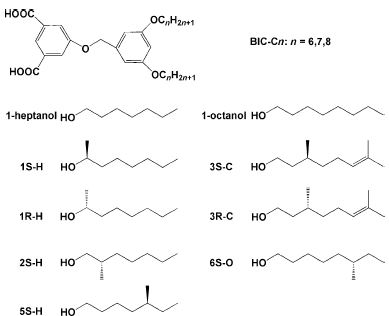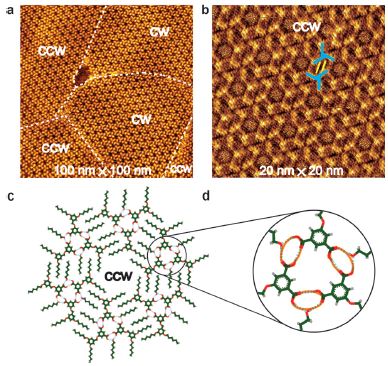Remote Chiral Communication in Coadsorber-Induced Enantioselective 2D Supramolecular Assembly at a Liquid/Solid Interface
Ting Chen, Shu-Ying Li, Dong Wang,* Man Yao, and Li-Jun Wan*
Angew. Chem. Int. Ed. Just Accepted Manuscript DOI: 10.1002/anie.201410927
Abstract: Remote chiral communication in 2D supramolecular assembly at a liquid/solid interface was investigated at the molecular level. The stereochemical information in a chiral coadsorber was transmitted over a flexible spacer with a length of up to five methylene groups to a 2D supramolecular assembly of achiral building blocks with the cooperation of specific hydrogen bonding between the chiral coadsorber and achiral building blocks and the confinement effect during 2D crystallization. When the position of the stereogenic center was changed with respect to the stereocontrolling moiety, an odd– even effect was found. A stereogenic center closer to the stereocontrolling moiety transmitted the stereochemical information to the 2D supramolecular assembly more reliably. This result is beneficial not only for mechanistic understanding of chiral communication in 2D supramolecular assembly on surfaces but also for the rational design of homochiral supramolecular assemblies on surfaces.

Figure 1. Chemical structures of BIC derivatives and alkyl alcohols. BIC derivatives are abbreviated as BIC-Cn, in which n is the number of carbon atoms in the alkyl chain. In the nomenclature of the coadsorbers, the first two characters indicate the position and spatial configuration of the stereogenic center, and the last letter denotes the backbone structure of the coadsorber, that is, H, C, and O represent heptanol, citronellol, and octanol, respectively.

Figure 2. a) Typical STM image of the enantiomorphous networks of BIC-C6 coassembled with 1-heptanol. b) High-resolution STM image of the CCW domain. c) Proposed structural model of the CCW network. d) Illustration of intermolecular interactions within the trimeric aggregations. Tunneling conditions: a) I=0.600 nA, Vbias=0.900 V; b) I=0.900 nA, Vbias=0.700 V.

Figure 3. Correlation of the coverage of CCW networks on the surface with the concentration of the coadsorber 1S-H or 5S-H as a solution in achiral 1-heptanol. The coverage percentage of CCW networks was deduced on the basis of the number of domains.
|

